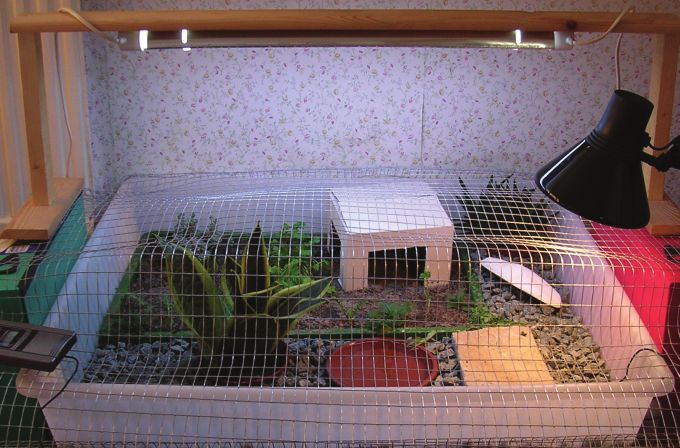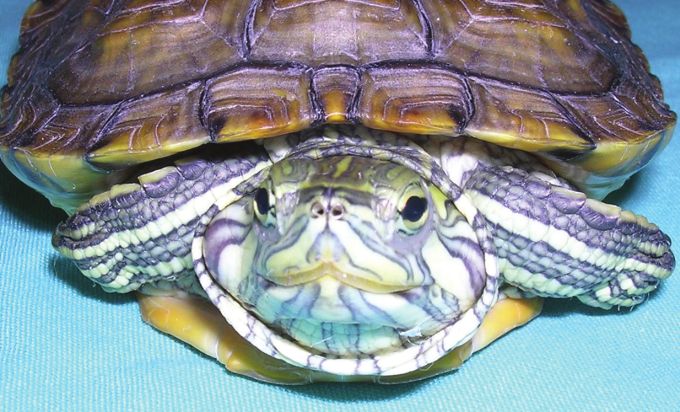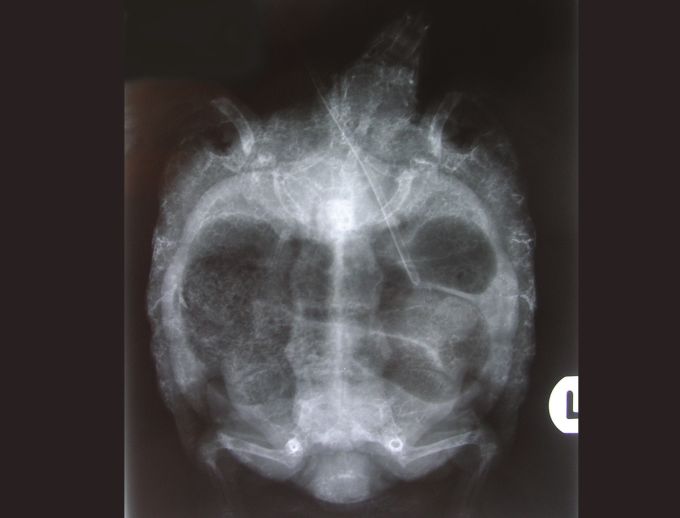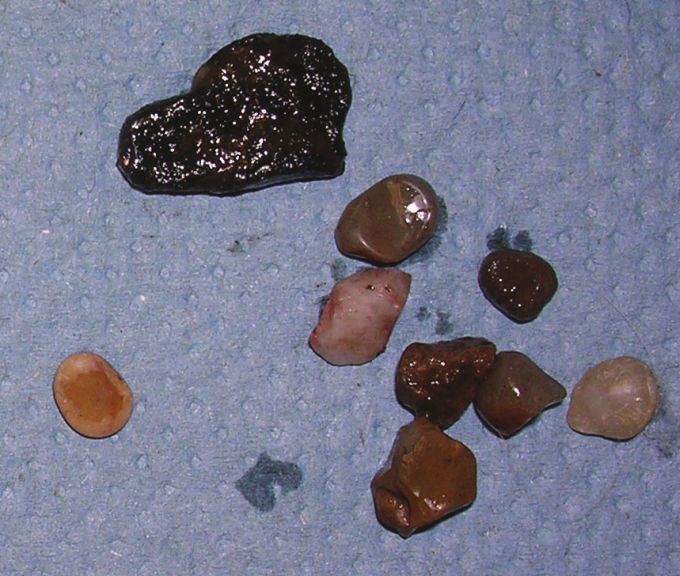Lesa Longley MA BVM&S CertZooMed MRCVS
Royal Zoological Society of Scotland Senior Clinical Training Scholar in Wildlife & Exotic Animal Medicine, Exotic Animal and Wildlife Service, Royal (Dick) School of Veterinary Studies, University of Edinburgh's Hospital for Small Animals, Easter Bush Veterinary Centre, Roslin, Midlothian EH25 9RG
Based on a presentation to the BCG Symposium in Milton Keynes on 8th March 2008
It is a common misconception among first-time owners that tortoises, terrapins and turtles will be easy to care for in captivity. Unfortunately a large proportion of chelonian cases presenting to veterinary practices relate to inappropriate husbandry (including diet and environmental conditions). More learned owners are unlikely to see such problems, but they serve as a warning to be mindful of every aspect of animal care. Besides treatment of specific ailments, an understanding by both veterinary surgeon and owner of appropriate husbandry techniques in these species is paramount to identification and correction of problems.
This article will describe a range of cases presented to the author over ten years in both first-opinion and referral veterinary practice. In some cases, it is not possible to identify one specific cause for a disease process as many factors interact to result in a condition. It is vitally important for the veterinary surgeon to obtain a detailed history of the animal’s source, environment and nutrition in order to assess the potential impact of deficiencies in any of these – or to rule them out as a cause for disease if they are appropriate for the species in question. Aspects of husbandry that frequently result in problems include those associated with the animals, housing, diet, and hibernation – these will be discussed separately with case examples.
Animals
Traditionally the most common species seen in the UK were Testudo species, but import and sale of these has been regulated by CITES legislation since 1984 and other species are now frequently seen as pets. Obviously there will be differences in husbandry requirements between species.
Problems can occur if different chelonian species are mixed, and species from different continents should not be housed together. It is difficult to provide suitable diets and environmental conditions for all animals. If males are present, sufficient space and escape areas are necessary, as they will mount and bite both companion males and females, particularly during the breeding season (Fig. 1). Although this article is about non-infectious disease, it should also be remembered that some infections may be carried without causing clinical signs in some species but cause significant disease in others (e.g. spur-thighed tortoises (Testudo graeca) are relatively resistant to herpes virus while Hermann's (Testudo hermanni) and Horsfield’s (Testudo horsfeldi) are most susceptible).
Housing
Various housing types are provided for pet UK tortoises. Some animals live outdoors, often year-round, particularly in the south of England. Juveniles may be kept in a vivarium with constant heating and lighting, although it is difficult to ensure sufficient ventilation in these and respiratory infections are common. Some owners have ‘house tortoises’, which have free-run of a room(s) for most of the day, but heating and lighting (particularly UV-B provision) is often sub-optimal for these animals. The author recommends the use of ‘table top’ enclosures when local climate does not permit outdoor access (Fig. 2).
It is normal to have some parasites in the gastrointestinal tract, and they are thought to assist with food breakdown. However, poor enclosure hygiene may allow re-infection from eggs in faeces and result in high worm burdens. Other husbandry problems concomitantly may cause immune suppression and reduce resistance to infection build-up. Clinical signs may include ill thrift and diarrhoea. Daily spot-cleaning and intermittent (every 2-3 months) complete disinfection of enclosures should reduce the risk of intestinal parasite problems.
Aural (ear) abscesses are also associated with poor hygiene. They are common in aquatic species (Fig. 3), but may occasionally be seen in tortoises. Surgery is usually required, removing the tympanic membrane (the skin over the ear) to allow cleaning of the ear canal. Improvement of the environment, in particular water quality, is necessary to prevent recurrence.
As most chelonia naturally live in warm climates, animals in the UK need supplemental heating to allow normal metabolic processes to occur. Insufficient heating may result in reduced activity and appetite, slowed digestion, and immune dysfunction. Heating can be provided using ceramic bulbs, tube heaters, and heat pads (the latter should be placed on the sides of enclosures to radiantly heat the carapace, and not underneath). Although thermostats are useful, they cannot be relied upon – digital thermometers should be used to monitor maximum and minimum temperatures in the animal’s enclosure.
Despite their hardy appearance, chelonia are prone to trauma from many sources. Examples the author has witnessed include attack from conspecifics (Fig. 1), dog bites (Fig. 4), lawnmower lesions, spade trauma, rodent trauma during hibernation, and enclosure injuries. Sharp edges or rough surfaces in enclosures may result in lesions if animals attempt to escape from an overcrowded enclosure, for example on the soft skin of the neck or limbs. Digit damage may progress to bone infection, which is very difficult to treat. Dog bites are all too common in smaller animals. Damage frequently includes shell fractures, exposing bone or even organs within the body cavity. These require thorough cleaning, often on repeated occasions, along with pain relief and antibiotics. Surgical repair of the shell may be necessary. Prevention of injuries is achieved by supervising animals, the use of fencing or an outdoor house (e.g. greenhouse), and controlled hibernation.
Reproductive problems in females may be caused by inappropriate husbandry, often due to a combination of factors. A lack of nest-site of suitable substrate may lead to egg retention (post-ovulatory egg stasis). Animals suffering from other disease or on a poor nutritional plane may be too weak to lay eggs. If ill for long periods, they may alternatively suffer from pre-ovulatory follicular stasis (with yolks forming on the ovaries but neither progressing to form eggs nor being absorbed as part of normal reproductive cycling). These females often need surgery to remove the ovaries with the follicles.
Respiratory diseases are common in captive chelonia. Underlying husbandry problems such as low temperatures and poor ventilation often reduce the animal’s immune function and predispose opportunistic infection that a healthier animal would not succumb to.
Diet
The modern trend in our society for convenience foods has extended to many pet owners. Free-ranging herbivorous chelonia eat relatively little, and survive on weeds and shrubs with fairly low nutritional value. Rather than providing an appropriate nutritional plane with home-grown weeds and flowers for herbivorous Mediterranean species, owners often feed supermarket salads that are lacking in fibre and minerals. Worse still, some older texts recommended feeding dog food that is excessively high in protein. Problems seen with these diets include beak overgrowth, shell deformities, and kidney disease.
Geochelone species such as African spurred tortoises (Geochelone sulcata) and leopard tortoises (Geochelone pardalis) eat mostly grasses, and are well fed on grass and hay in captivity. Omnivorous species such as box turtles (Terrapene species) and red-eared sliders (Trachemys scripta) are more difficult to feed due to species variations – requiring a selection of vegetation, fruit, fungi, invertebrates (e.g. crickets and Tubifex) and vertebrates (e.g. pinkies).
Vitamin and mineral supplementation requirements vary between species and life-stage. All chelonia require appropriate levels of calcium and phosphorus, and access to UV-B light to utilise these minerals. Without any of these, problems such as metabolic bone disease (more properly called nutritional secondary hyperparathyroidism in this case) may develop. Animals will have soft shells and reduced minerals in their bones (Fig. 5). They may also have problems with gut motility, sometimes prolapsing part of the intestinal tract through the cloaca, and females are prone to reproductive disease (as described above). Inadequate levels of vitamin A may result in swellings of the eyelids, conjunctiva, and ocular discharge. In some animals, the eyes may close, the animal becomes blind, and often inappetant and lethargic. This is relatively common in terrapins, and easily corrected by supplementing vitamin A and correcting the diet.
By the time chelonia become inappetant, they are often quite unwell. Initially, offering tempting foods and hand feeding may suffice, but if the animal refuses this then assist feeding by gavage (i.e. passing a tube through the mouth into the oesophagus near the stomach) is necessary. When the inappetance is prolonged, a feeding tube may be placed through the side of the neck into the oesophagus to enable easier feeding that is less traumatic to the animal (Fig. 5). These tubes are small enough to allow the animal to eat and swallow around when its appetite returns, and the tube can be left in place for several weeks if needed. Food administered via tubes should be as close to the natural diet as possible, to provide good nutrition and maintain normal gastrointestinal function. Puree’d foods or dairy-free baby foods may be used (e.g. vegetable varieties for herbivores and meat/vegetable varieties for omnivores), although for herbivorous species special critical care diets designed for herbivore mammals are better as they contain more fibre. Carnivore critical care diets are manufactured for dogs and cats, and can be used in omnivorous or carnivorous chelonia.
Tortoises appear to be relatively resistant to plant substances that are toxic to other species such as cattle and sheep. However, some substances are still toxic to chelonia. Daffodil leaves and flowers cause liver and gastrointestinal disease. Lead has been shown to reduce survivability of hatchling sliders. Pesticides such as organochlorines suppress the immune system. The environment should be checked for any toxic plants, and chemicals not used in the enclosure.
A more common problem with tortoises is their appetite for all manner of foreign materials, including stones and pieces of metal that may cause obstructions in their intestines (Fig. 6). Many small items will pass through the intestinal tract (sometimes with supportive treatment such as fluid supplementation and gut motility stimulants), but some require surgery for removal.
Hibernation
As with housing, there are several ways tortoises are hibernated in the UK. In the milder climes of southern England, animals may hibernate in gardens. However, in colder areas such as Scotland a more managed approach is required – either using insulated boxes in a loft or outhouse (ensuring the temperature does not drop below freezing) or in a refrigerator. Whatever method is used, tortoises are starved for a month to allow the intestinal tract to empty. Environmental temperature and day-length are gradually reduced to stimulate the tortoise to hibernate.
It is important to monitor the tortoise during hibernation, ideally with regular weight checks (difficult if your tortoise has buried itself in your garden!), checking for urination, and continuous temperature monitoring using a digital thermometer. Problems that may occur during hibernation include dehydration if urination occurs, cataracts due to freezing, or rodent trauma. Post-hibernation anorexia is a multi-factorial problem, and is often associated with husbandry deficits or disease in the year(s) before hibernation commenced.
Conclusion
Chelonia are a pleasure to keep as pets, but require close monitoring to optimise their health. Attention to provision of appropriate diet and safe enclosure design should minimise risks of non-infectious diseases. When problems occur, treatment involves correction of any husbandry problems as well as appropriate veterinary care.
Figures courtesy of Lesa Longley.
Testudo Volume Six Number Five 2008
Top








